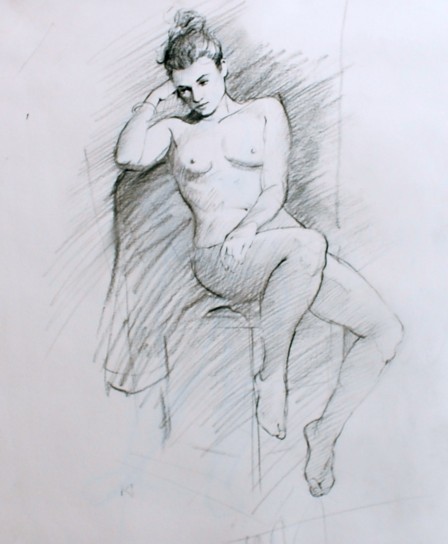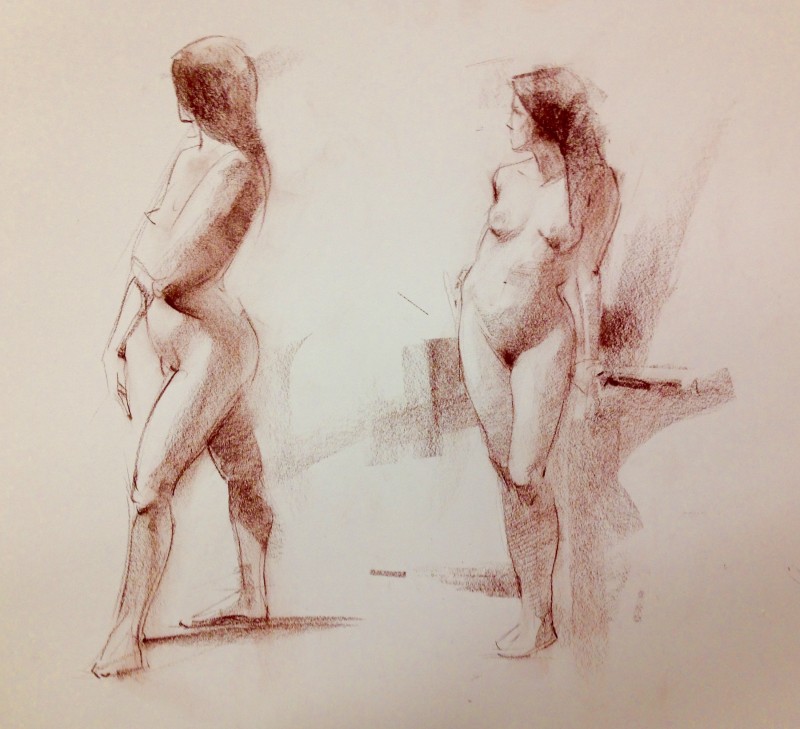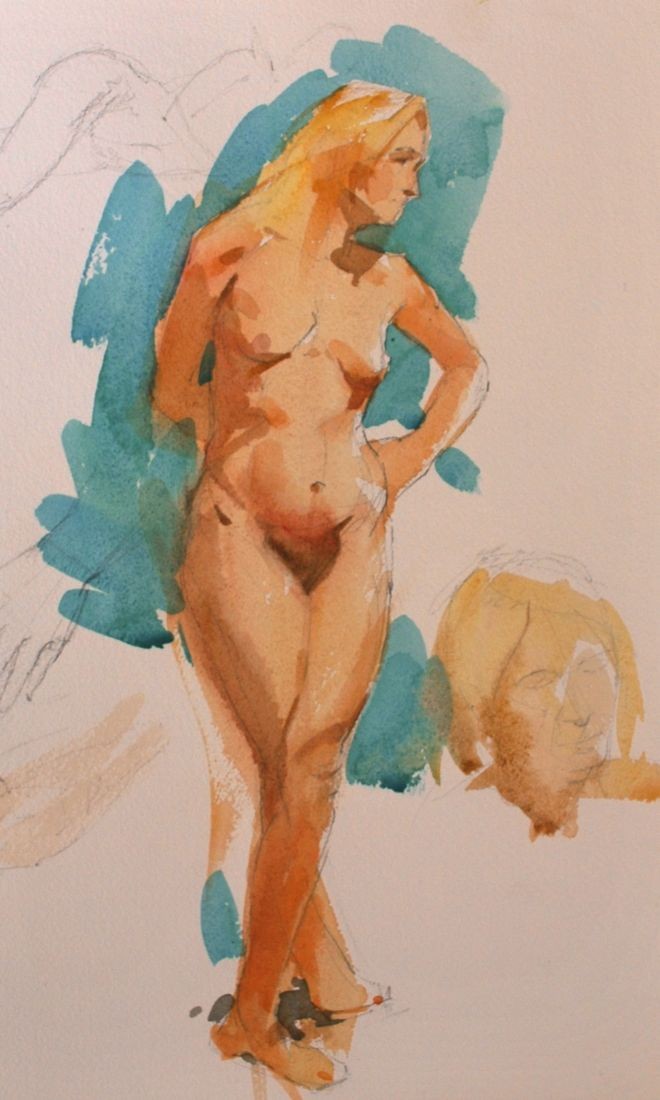Re-discovering the Cont’e crayon, an often overlooked artist’s tool, with encouraging results.
Continue readingPinterest Piques My Interest
In the last few months, I’ve really discovered the value of Pinterest as a very helpful teaching tool. Considering my mild-to-moderate aversion to technology as the answer to everything, this is a concession that I happily make.
Students in my Plein Air, Life Drawing and Portraiture classes are constantly encouraged to look at really good examples of the work of accomplished artists. The difficulty is that they often don’t find the time, recall the names, or know the best ways to investigate the artist’s I’ve suggested. So up to this point, it’s been up to me to bring in examples from books from my personal library or reference files I’ve accumulated. Lot’s of lugging around (and plenty of wear and tear) on out-of-print art books and catalogs that are pretty precious to me.
Then along comes Pinterest.
Using it as a resource, I’ve created boards for each group I teach. Students are reminded, often, to check the Pinterest boards I have up on my page, especially when I’m involved in a one-to-one critique and see a problem that would benefit from an illustration.
For example, ” Composition” is helpful for every student, but especially the Plein Air and Portrait folks. They are usually fully occupied with making things look like what they’re seeing, and of course need to consider the design of the elements as an important factor. With the examples I’ve collected on Pinterest they can see some really interesting uses of pattern and placement that might spark their interest and encourage spending more time on design.
For Life Drawing, there are many beautiful and compelling images of fine drawings available. Beautiful touches, line variety, pieces that reveal construction (The Carravaggio is full of lessons) all to show the tremendous possibilities. Ingres’ drawing of his house cat reminds that there are worthy subjects everywhere, even to the most sophisticated talent.
The “Portrait” group is equally filled with great things, featuring artist’s that are both famous as well as those often overlooked today. And finally, “Technique” is a broadly based collection of interesting and masterful uses of various mediums.
If you are interested in seeing the boards I’ve assembled, just follow the link.
And if I may encourage you, please feel free to grab whatever you like and start your own boards. Great fun and very valuable.
A Figure Drawing with Watercolor Wash
In my Life Drawing Studio class, I sometimes enjoy adding the element of color when the pose is an hour or longer in duration. Watercolor is a convenient and sometimes ideal way to go…thoughI have to admit that if the drawing aspect isn’t working, no amount of color work will make up for such a weakness, and so I don’t recommend it to students until they are well on their way.
For anyone who wishes to give it a go, I ‘d recommend starting with monochrome wash until you’ve got a mastery over wash, know your brushes and paper (which need to be of good quality), and especially the drying characteristics of your paper. I use Arches 140 lb and Saunders 200lb, which are both great papers.
My normal watercolor palette, which is primarily used out-of-doors, includes the following colors that are perfectly suited for figurative work:
Raw Sienna, Naples Yellow, Cadmiums Orange, Yellow, Lemon, and Scarlet, Indian Red, Light Red, Alizarin Crimson, Permanent Rose, Raw and Burnt Umbers, and Ivory Black. These, in addition to the blues, greens and other colors I regularly employ, are a well rounded group for general painting indoors or out.
A Special Workshop-The Figure in Watercolor October 6-7
I have a peculiar relationship with self promotion. While I want very much for people to see my work (that’s half of the equation), I possess a reluctance to market myself conspicuously. I don’t much like discussing the sales of my paintings outside family and closest friends, or operating as if I’m luring the unwitting into the artist’s version of a car dealership. I like to keep the work and the selling somewhat compartmentalized. This blog is an example, I don’t get into selling here, I would like readers to just come aboard and visit without a subtext.

That said, I now would like to brief my reading public on something that I’ve been working on that has me excited a bit beyond all reason, a special watercolor workshop on painting the figure.
As you may know, watercolor was my first love-experience in painting, and while I don’t participate in it full time, I am perfectly comfortable working in it, and I often return to it for the working out of those subjects where watercolor is appropriate. Also, I confess here rather remorsefully that I have a contrarian streak at times, one that chafes at some of the goings-on in the watercolor world. There are great things being done by very talented people, certainly. But I also see very sincere painters-in-the-making that are struggling with some very basic and essential things about making paintings. They seem to go in circles, relying on method rather than really seeing, and hoping that tips n’ tricks might carry their work. As a result they often stumble on the subject of the figure, and so that is the focus of the workshop I’m conducting in October.
Here’s what I’m doing:
My first step has been to analyze and address the repeated problems that I noticed watercolor painters incur. They are summed up in the workshop credo I developed:
We are always looking ~We are always designing~ We are seeking fluency~We are wiling to practice.
There was a fifth We are artists first, watercolorists second, but I dropped it, it’s a bit much though it speaks to the problem of separating “watercolor” from painting in general, an error I believe.
Next, I created a power point presentation to address and demonstrate each of these necessary attitudes. I spent way too much time on making this, but found myself really excited to show what I think is a valuable point of view on the matter.
First, there’s a whole section on the study of master drawings. People need to see the great work of the past, and why it’s great. Rembrandt’s wash drawings are a great lead-in to the importance of seeing your everyday world, taking clues from your immediate surroundings and doing something with them. Then, committing oneself to a lifestyle of continued eye-opening, sketching, and active participation in development of one’s work as a designer, taking what’s around you and shaping it. I also have a section on my own favorite painters in watercolor, many of whom students are unfamiliar with, because I believe that to gain fluency, you need heros and mentors. Zorn,Sargent, Seago, Bonnington, and others have influenced me greatly, and I’m very happy to introduce some favorite works by them.
The workshop itself will be fun, I’ve developed a series of exercises to deal with everything from the slight indications of the figure in the landscape, sketching habitually, memory work, and finally to working directly from the live model.
Below is one piece I developed to market the workshop, I’ve posted it in the past. It’s developed totally from imagination and recollection of all sorts of things, which is something I’ve taught myself to do. I want students to understand that this is possible, it’s an attempt at fluency and integrating their life experience and their craft. It’s simply the sort of liberating and challenging work that I think artists, generally speaking, should some how be up to attempting. Without photos… those will always be around anyway.
For more information, email me at mark@marknorseth.com or call the Academy at 808.532.8741. I believe we have only 3 spaces left. Could be a game changer.
Maintaining an edge~ new drawings from Life
These are some images from the last few months or so. Relatively short poses, mostly under an hour.

I’ve been pursuing a more seasoned and sensitive description, allowing for more construction and “thinking out loud” with line.
I’m sticking with charcoal and carbon pencils for a few months, and I’ll possibly go into a Cont’e crayon-mode or other red chalk next. They have possibilities I haven’t explored enough. I make it a habit to work with a single medium for a several month stretch, and then rotate to another so that by the end of a year I may have worked in three or four drawing media. So much of progress is showing up, being energized and diligent, but without going stale. Switching up mediums like that helps, but it doesn’t affect structural or perceptual problems.

I’m still not (often enough) seeing or taking-in the whole form at once…something I’ve been able to do on occasion in the past. By this I mean seeing the part, an arm or whatever, and it’s place in the entire figure almost simultaneously and drawing it that way. Tricky stuff, but I know there’s a groove where I’ve managed it before, and when it happens it’s where you know you ought to be.

I’m thinking that each drawing, good or bad, is a brick in the wall of your experience. It’s the sharpening of the eye and refining one’s shortcomings that really matters with these, a nice drawing is the by-product. Not that I don’t shoot for a nice drawing each time. I do, but I find my own criteria for that drawing has changed a bit. I like chatter in my drawings now, and enjoy seeing bits of construction showing about, maybe even a finger print or two.

I found myself telling a student last night that one shouldn’t “speak in monotone”, that is, draw with a line that has no inflection or personality. I was surprised that analogy came up, but I think it’s helpful.

There’s a nice season where one measures diligently, renders exactly, and goes as far as they can that way, as far as their talent, training, and knowledge can take them. I wish it could last forever sometimes, because to get buried in a drawing for hours, for it’s own sake, is fun. But, now I need to make use of what skills I may have obtained to make things that find their way into the marketplace, my objectives being in paint these days.

Thankfully, I have the blessing of regular weekly classes and motivated students where I can maintain some edge to those skills, an endless process I thoroughly enjoy.







